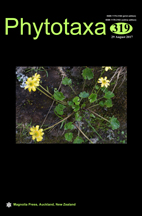Abstract
The name Salicornia cuscoensis given to a plant from high Andean saltmarshes near Cusco [Cuzco] and Ayacucho, Peru (South America) is validated by a diagnosis and description. The main morphological characters that separate S. cuscoensis from other closely related species are creeping habit, delicate branches, inflorescence of short and thin spikes, and seed indumentum. The new species clearly differs from other perennial Salicornia taxa growing in high Andean saltmarshes such as S. pulvinata and S. andina. The former forms small compact cushions producing very short, few-flowered inflorescences. The latter shows woody stems and forms larger rounded carpets. Morphologically, S. cuscoensis is also similar to S. magellanica, a species growing along the seashore in southern Patagonia and Tierra del Fuego, but the latter has shorter and wider inflorescences and larger seeds with a different type and arrangement of indumentum. Molecular analyses also supported the separation of S. cuscoensis. Data on habitat, distribution and phylogenetic relationships are presented for the new species and its relatives, and an identification key is given for the South American taxa of the genus Salicornia.

